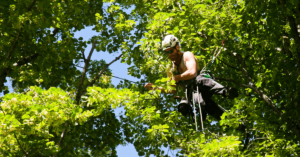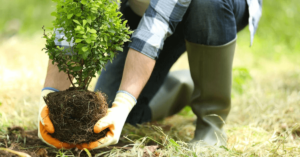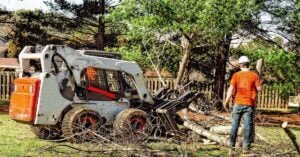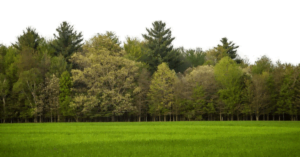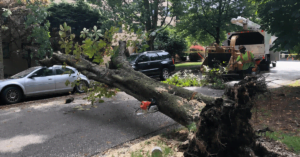Hurricane season brings with it powerful winds and heavy rainfall, which can result in fallen trees and damaged landscapes. Dealing with the aftermath of a hurricane can be overwhelming, but it’s important to handle fallen trees safely and efficiently to prevent further damage and ensure the safety of those around you.
In this post, we will discuss how to handle fallen trees or branches after a hurricane, including removal techniques and safety considerations. By understanding the process beforehand, you’ll be better prepared for dealing with any debris left behind by the storm.
How to Handle Fallen Trees After Storm?
When a hurricane hits, it can leave behind a lot of damage in its wake. Trees that have fallen due to the wind and rain can cause further destruction if they’re left unchecked. In this article, we’ll go over how to properly handle fallen trees after a hurricane.
The first step is assessing the damage. Look at the fallen tree and determine if it is blocking a road or creating a public hazard. If it is, contact your local authorities immediately to ensure that the situation is handled promptly.
Once you have assessed the situation, decide whether or not you need to call in professional help for removing the fallen tree. If the tree is smaller and not blocking public access, you may be able to remove the tree yourself.
If you decide to proceed with removing the fallen tree on your own, make sure that you are using appropriate safety equipment such as gloves and protective eyewear. Additionally, use a chainsaw or other cutting tool to cut up the branches and trunk into smaller, easily manageable pieces.
Finally, dispose of the fallen tree properly. Depending on the size and type of tree, you may be able to use a wood chipper or mulcher to shred it into compost material. If not, contact your local waste management service provider for proper disposal instructions.
Safety Precautions While Storm Damage Tree Removal
Here are some key safety Precautions to keep in mind before dealing with fallen trees or branches:
- Personal protective equipment: Wear a hard hat, gloves and eye protection. Doing so will help protect you from any flying debris or splinters.
- Awareness of power lines: Fallen trees may have downed power lines that can still be live. Be sure to look for them before taking action and stay away from them if necessary.
- Other hazards: Also be aware of any other hazards such as nails, broken glass and sharp objects that could cause injury.
Assessing the Damage
Before taking any action, it’s important to assess the damage caused by a fallen tree. Here are some considerations:
- Determining if the tree is stable: If the tree has fallen in one piece and is not leaning heavily on another object or structure, it can likely be removed safely. On the other hand, if the tree is leaning on something or has broken into several pieces, it should be approached with extra caution.
- Evaluating the damage to surrounding property: Look closely at any objects or structures that have been damaged by the storm and make note of them to inform any cleanup efforts.
Removal of Fallen Trees After Storm
As previously mentioned, fallen trees can be hazardous if not removed correctly. Here are some tips for removing them safely:
- Calling in professionals: When dealing with a large tree or complicated situation, it’s best to call in professionals tree arborist near you who have the right tools and safety equipment to handle the job properly.
- Cutting up and removing debris: If you decide to handle the removal yourself, use proper cutting techniques such as saws and chisels. Be sure to wear protective equipment while doing so.
- Disposing of the debris: Once the tree has been cleared away, it’s important to dispose of any debris properly. This may include hauling it away, chipping it into mulch or burning it. Be sure to follow any local laws and regulations when disposing of debris.
Cleaning Up the Area After Tree Removal
Once a fallen tree has been removed, it’s time to clean up the area. Here are some tips for doing so:
- Clearing debris: Use a rake or other tool to clear away any tiny pieces of debris left behind. Be sure to dispose of these properly as well.
- Repairing damaged property: If any structures or objects were damaged in the storm, they should be repaired as soon as possible. This could include replacing shingles on a roof or repainting a fence.
- Replacing damaged trees: Once the area has been cleaned up, consider replacing any fallen trees with new ones. Doing so will help restore the area and keep it looking beautiful.
Prevention Measures
Here are a few tips to help you get started with commands and prevent damage from storms:
- Proper Tree Care & Maintenance: Regularly prune trees, remove dead or dying branches and limbs and inspect the health of your trees to prevent damage from storms. Pruning should be done according to the specific needs of each species of tree, so it is best to consult a certified arborist for advice on proper pruning techniques.
- Planning for Future Storms: When planning for future storms, assess the potential risk your property may face and consider measures that can be taken to mitigate storm damage such as installing lightning rods or adding supports for weak branches. Additionally, make sure you have an emergency plan in place in case of severe weather, including evacuation routes and designated shelters where family members can take shelter.
- Preparing a Disaster Plan:When preparing a disaster plan to protect yourself and your family in the event of a storm, make sure you include important documents, insurance information, financial records and personal identification. Additionally, make sure that everyone in the family is aware of the plan and knows how to respond if a storm occurs safely.
By taking proper tree care and maintenance, planning for future storms and preparing a disaster plan, you can better prepare yourself and your family for the effects of severe weather. With these steps in place, you can protect your home and loved ones from storm damage.
Conclusion
If you find yourself in the aftermath of a hurricane with a downed tree, there are some steps you can take to ensure your safety and the safety of those around you.
First, assess the situation and if possible, call for professional help. If you must remove the tree yourself, be sure to take all the necessary precautions and have a plan in place before beginning. With some careful planning and execution, you can handle this daunting task and minimize any further damage.

